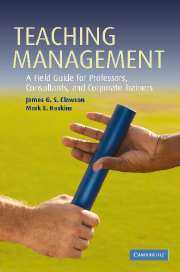Book contents
- Frontmatter
- Contents
- List of figures
- Sources to chapter quotations
- Why this book on teaching management?
- 1 Fundamental elements in teaching
- 2 Levels of learning: one, two, and three
- 3 Adult learning theory: it matters
- 4 Planning a course: trips and tips
- 5 Planning a class: no detail is too small
- 6 Lecturing: the possibilities and the perils
- 7 Managing discussions
- 8 Case method: fostering multidimensional learning
- 9 Role-playing
- 10 Case writing: crafting a vehicle of interest and impact
- 11 Case teaching notes: getting from here to there
- 12 Action learning
- 13 Experiential methods
- 14 Enhancing the conversation: audiovisual tools and techniques
- 15 Executive education: contributing to organizational competitive advantage
- 16 Using technology to teach management
- 17 Counseling students
- 18 Evaluating students: the twin tasks of certification and development
- 19 Teaching evaluations: feedback that can help and hurt
- 20 Research presentations
- 21 Managing a degree program: behind the ‘glory’
- 22 Managing a nondegree client program: an overview
- 23 Dealing with the press
- 24 Managing yourself and your time
- 25 Using teaching portfolios and course portfolios
- 26 Conclusion: is this on the exam?
- Index
6 - Lecturing: the possibilities and the perils
Published online by Cambridge University Press: 25 February 2010
- Frontmatter
- Contents
- List of figures
- Sources to chapter quotations
- Why this book on teaching management?
- 1 Fundamental elements in teaching
- 2 Levels of learning: one, two, and three
- 3 Adult learning theory: it matters
- 4 Planning a course: trips and tips
- 5 Planning a class: no detail is too small
- 6 Lecturing: the possibilities and the perils
- 7 Managing discussions
- 8 Case method: fostering multidimensional learning
- 9 Role-playing
- 10 Case writing: crafting a vehicle of interest and impact
- 11 Case teaching notes: getting from here to there
- 12 Action learning
- 13 Experiential methods
- 14 Enhancing the conversation: audiovisual tools and techniques
- 15 Executive education: contributing to organizational competitive advantage
- 16 Using technology to teach management
- 17 Counseling students
- 18 Evaluating students: the twin tasks of certification and development
- 19 Teaching evaluations: feedback that can help and hurt
- 20 Research presentations
- 21 Managing a degree program: behind the ‘glory’
- 22 Managing a nondegree client program: an overview
- 23 Dealing with the press
- 24 Managing yourself and your time
- 25 Using teaching portfolios and course portfolios
- 26 Conclusion: is this on the exam?
- Index
Summary
I would hesitantly ask if I should do the Darwin lecture with or without songs.
– Richard Milner, anthropologistLecturing is probably the most common form of organized instruction in the world. For many of us, the notions of college teaching and lecturing are so closely aligned that we automatically think of the latter when we think of the former. Indeed, many universities officially designate certain faculty appointments as Lecturer. That lecturing is so common does not, however, make it necessarily the best method of instruction nor does it mean that it is not amenable to the best features of other instructional styles – even singing!
Six preliminary points
Before focusing on a variety of lecture-related specifics, six overarching points are important to note. First, lecturing requires special attention and practice to become skilled at it. Effective lecturing is neither the mere reading of notes nor the casual regurgitation of facts. At its most fundamental level, lecturing is the verbal conveyance of one's robust topical understanding to another. Doing that in less time, more poignantly, and with greater student retention is a skill to be crafted through thoughtful planning, trial and error, frequent reflection, careful craftsmanship, and the observation of others.
The second point is that good lecturers work with the differences in learning styles resident in their audiences. The earlier chapter on adult learning described the stream of research called neurolinguistic programming that posits three fundamentally different learning patterns: audio, visual, and kinesthetic. Any moderately large lecture audience is likely to have each kind of learner in it.
- Type
- Chapter
- Information
- Teaching ManagementA Field Guide for Professors, Consultants, and Corporate Trainers, pp. 83 - 102Publisher: Cambridge University PressPrint publication year: 2006



